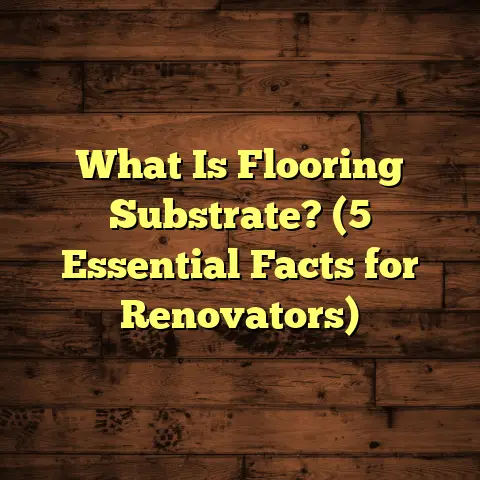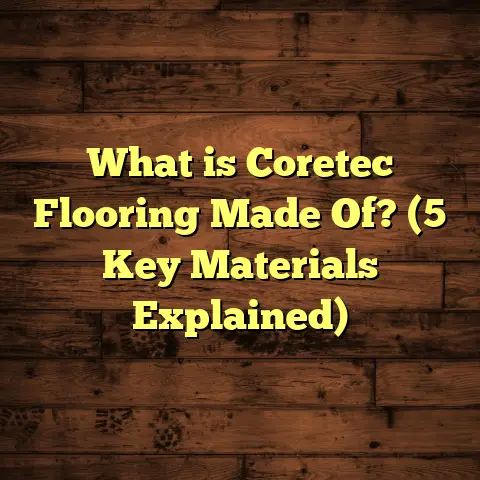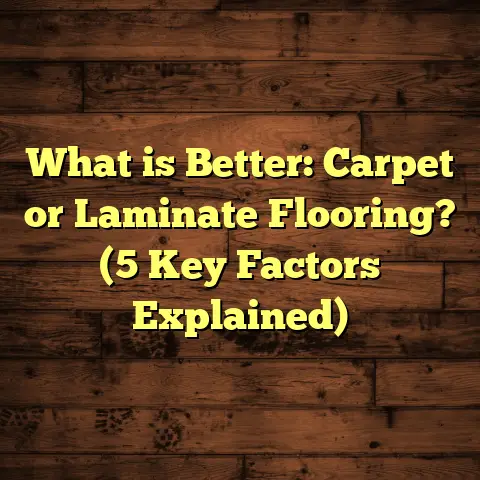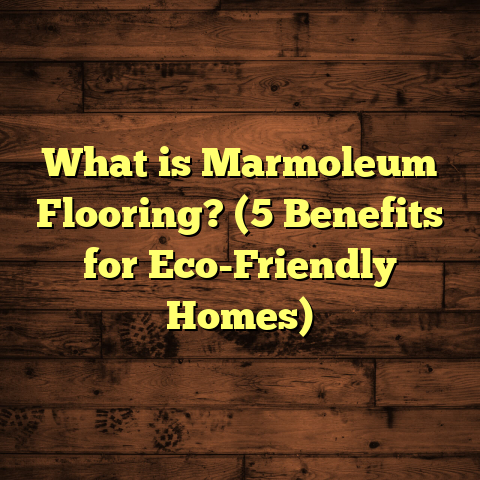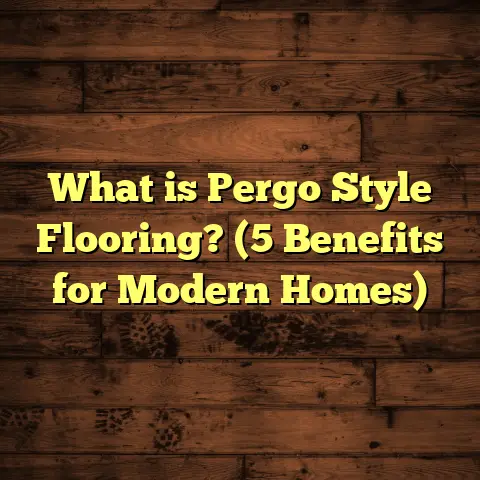What is Solid Strand Woven Bamboo Flooring? (5 Benefits You Can’t Ignore)
Have you ever wondered what makes some floors last for decades while others start to show wear within just a few years? I’ve been working with flooring materials for a long time, and one product that consistently catches my attention is solid strand woven bamboo flooring. It’s not just because it looks great or feels sturdy underfoot—there are deeper reasons why this flooring option keeps gaining popularity among homeowners and contractors like me.
What is Solid Strand Woven Bamboo Flooring?
Let me break it down for you. Solid strand woven bamboo flooring is a type of bamboo floor made by compressing shredded bamboo fibers under intense heat and pressure. Unlike traditional bamboo planks, which are cut from the stalks, this method creates a dense, highly durable board. The fibers are mixed with adhesives and then pressed together to form a solid plank. This process results in a floor that’s harder and more resilient than many hardwoods.
What’s cool about this is that the manufacturing technique changes everything about the bamboo’s properties. Instead of just slicing the stalk and laminating pieces, the shredding and weaving process binds the fibers tightly, giving it an impressive strength that stands up to heavy foot traffic and even impacts better than many woods.
I remember installing solid strand woven bamboo in a busy family home where kids and pets ran wild daily. After two years, the floor looked almost new—no deep scratches or dents in sight. That kind of durability is hard to find in traditional floors without spending a fortune.
A Closer Look at the Manufacturing Process
The manufacturing process is what makes solid strand woven bamboo stand out from other flooring types. The raw bamboo stalks are first harvested, then shredded into strands. These strands are mixed with adhesives—usually formaldehyde-free nowadays to reduce off-gassing—and then compressed at extreme pressure (about 1,200 psi or higher) and heat (around 350°F).
This compression essentially fuses the strands into one solid board. Because the fibers are interwoven in multiple directions before compression, the resulting plank is dense and less prone to splitting or warping.
Interestingly, this process also allows manufacturers to use bamboo fibers from the entire stalk, including parts that might be discarded in traditional flooring methods. This results in less waste and more efficient use of raw materials.
5 Benefits You Can’t Ignore
1. Exceptional Durability
If you ask me, the biggest selling point for solid strand woven bamboo is its toughness. On the Janka hardness scale, which measures wood hardness, strand woven bamboo clocks in between 3,000 and 3,800 pounds of force. For comparison, red oak—a common hardwood flooring choice—scores about 1,290 pounds. That means this bamboo is nearly three times harder than oak!
This strength translates directly to floors that resist dents, scratches, and wear over time. I’ve worked on projects where clients have dogs, kids, or busy households, and the solid strand woven bamboo floors still look fantastic years later.
One particular project sticks in my mind: a daycare center where the kids were constantly running around and dragging toys across the floor. After a year of heavy use, the floor showed only minor scuffs that polished out easily during routine maintenance.
The durability also makes it a smart choice for commercial spaces like cafes or boutique stores where foot traffic can be intense but aesthetics still matter.
2. Eco-Friendly and Sustainable
Here’s something I really appreciate about bamboo: its fast growth rate. Bamboo can mature in about 5 years compared to hardwood trees, which often take 20-50 years. Because solid strand woven bamboo uses shredded fibers from the entire stalk, it maximizes material use with minimal waste.
In my experience, clients who want to reduce their environmental footprint often choose this flooring because it’s a renewable resource harvested sustainably. Plus, many manufacturers use low-VOC (volatile organic compounds) adhesives and finishes, improving indoor air quality.
I once helped a client who was passionate about green building certifications like LEED. They chose strand woven bamboo flooring as part of their whole-house sustainable design strategy. The rapid renewability of bamboo helped earn credits toward their certification.
Additionally, when comparing carbon footprints, bamboo has a clear advantage. According to a study by the World Bamboo Organization, producing one square meter of solid strand woven bamboo flooring results in approximately 60% less carbon emissions than producing an equivalent amount of oak hardwood flooring.
3. Moisture Resistance
One of the tricky parts of flooring is dealing with moisture, especially in kitchens or basements. Solid strand woven bamboo tends to handle humidity changes better than traditional hardwood because of how tightly the fibers are compressed.
I installed strand woven bamboo flooring in a home near the coast where humidity fluctuates daily. The floor barely expanded or contracted compared to other floors I’ve seen in similar conditions. This stability helps prevent warping or buckling over time.
A lot of clients ask me if bamboo is safe for bathrooms or basements. While solid strand woven bamboo is more stable than many hardwoods, it’s not completely waterproof. It’s best used in areas with moderate moisture levels but not places where it could be submerged or exposed to constant water.
If you live somewhere with high humidity or seasonal variation, this flooring still performs well because it expands less than traditional wood floors do.
4. Aesthetic Versatility
The natural grain pattern of strand woven bamboo is unique—it looks more textured and variegated than smooth traditional hardwood floors. It can be finished in various stains or left in its natural golden tone.
I’ve found that this flooring fits well with modern, rustic, or even industrial styles. One homeowner wanted an eco-friendly floor but didn’t want the typical bamboo look; we went with a darker stain, and it gave the space a rich, sophisticated vibe that surprised everyone.
The visual depth comes from how the fibers are interwoven—almost like a natural mosaic—which adds character without overwhelming a room’s design.
You can also find solid strand woven bamboo in different plank widths and lengths, allowing customization based on room size and style preference.
5. Cost-Effectiveness Over Time
At first glance, solid strand woven bamboo might seem pricier than laminate or some engineered woods. But here’s what I’ve learned: factoring in durability and maintenance costs changes the equation.
For example, a typical solid strand woven bamboo floor costs around $5 to $8 per square foot for materials alone. Installation varies but usually falls between $3 to $6 per square foot depending on complexity and location.
What really counts is how long it lasts without needing replacement or heavy repairs. Hardwood floors might need refinishing every 7-10 years at a cost of $2 to $4 per square foot or could get damaged more easily requiring patching.
To manage my own projects better, I use FloorTally—it helps me estimate total costs quickly by including materials, labor, and even waste factors based on local rates. It saves me from surprises during budgeting and helps clients see where their money goes clearly.
If you compare total cost of ownership over 15-20 years rather than just upfront price tags, solid strand woven bamboo often comes out ahead due to its longevity and low maintenance needs.
How Solid Strand Woven Bamboo Compares to Other Flooring Options
Bamboo vs Hardwood
Hardwood has been a standard for decades but has some challenges: it takes longer to grow (20-50 years), can dent easily depending on species, and needs refinishing every so often.
Solid strand woven bamboo offers comparable hardness but grows much faster which makes it more sustainable.
Bamboo vs Laminate
Laminate is budget-friendly but not as durable long-term and can’t be refinished. Bamboo offers real wood fiber composition with better resilience and can be refinished if needed.
Bamboo vs Vinyl
Vinyl performs well with moisture but doesn’t have the same natural appeal or lifespan as solid strand woven bamboo.
Bamboo vs Engineered Hardwood
Engineered hardwood has layers of plywood topped with real wood veneer. It’s more stable than solid hardwood but typically not as hard as strand woven bamboo.
Installation Tips From My Experience
Installing solid strand woven bamboo requires care but isn’t complicated if you follow these steps:
- Acclimate Properly: Always store planks in the room where they’ll be installed for at least 72 hours.
- Prepare Subfloor: Make sure it’s clean, dry, flat within 3/16 inch over 10 feet.
- Choose Installation Method: Solid strand woven bamboo can be nailed down or glued depending on subfloor type.
- Leave Expansion Gaps: Like all wood floors, leave about 1/4 inch gap around edges.
- Use Quality Adhesives: If gluing down, pick adhesives designed for bamboo for best bond.
- Finish with Care: If unfinished planks are used (less common), apply polyurethane finish after installation.
I always remind homeowners that proper installation can make or break the floor’s longevity.
Maintenance Secrets That Save Time and Money
Keeping your floor looking great doesn’t have to be hard:
- Sweep or vacuum regularly to keep grit off surface.
- Use microfiber damp mops rather than soaking wet mops.
- Clean spills quickly.
- Avoid harsh cleaners—stick to pH neutral products designed for wood/bamboo.
- Use felt pads under furniture legs.
- Consider occasional buffing or reapplication of finish every few years depending on wear.
In my experience with repeat clients, those who stick to these simple habits enjoy beautiful floors that last decades without costly repairs.
Real-Life Case Studies From My Work
Case Study 1: Family Home With Pets
A client came to me frustrated with scratched hardwood floors caused by their two dogs. We installed solid strand woven bamboo throughout the main living area and kitchen—about 900 sq ft total.
After two years, they reported minimal scratches despite daily pet activity. The floor maintained its shine after routine cleaning and occasional buffing.
Case Study 2: Commercial Café Space
A local café wanted a warm look but needed something tougher than oak due to heavy customer traffic plus cleaning routines involving mop buckets and carts.
We installed solid strand woven bamboo with a commercial-grade finish over 1,200 sq ft area. After six months of operation, floor managers noted minimal wear marks compared to previous floors which needed replacing every few years.
Case Study 3: Coastal Home With Humidity Challenges
Near the oceanfront, one client struggled with warping floors from moisture swings. We recommended strand woven bamboo due to its superior dimensional stability.
After installation across all living spaces (approx 1,500 sq ft), they reported no warping after one year despite high humidity variations seasonally.
More Questions You Might Have
Is solid strand woven bamboo environmentally friendly?
Yes! Its fast renewability combined with low-emission adhesives makes it one of the greener flooring options available today.
Can I install solid strand woven bamboo over radiant heating?
Absolutely. It works well over radiant heat systems if proper acclimation and installation guidelines are followed.
How long does this flooring last?
With proper care, expect 20-30 years or more before replacement becomes necessary.
Is it safe for allergy sufferers?
Because it doesn’t trap dust like carpets do and uses low-VOC finishes typically, it’s a good choice for people sensitive to allergens.
Final Thoughts from My Experience
Choosing flooring means balancing looks, lifestyle needs, budget, and long-term value. Solid strand woven bamboo nails all these aspects nicely—with durability that outperforms many woods, sustainability that fits eco-conscious choices, visual appeal that adapts to varied styles, moisture resistance for tricky environments, and cost-effectiveness when you consider its lifespan.
If you want real-world proof beyond marketing hype: I’ve installed it dozens of times across diverse settings—from busy homes with kids and pets to commercial spaces demanding toughness—and every time it holds up beautifully with minimal fuss.
Using tools like FloorTally has helped me plan budgets clearly—factoring in local labor costs plus waste factors ensures no surprises during installation phases. If you’re planning your own project, getting detailed estimates early can save headaches later on.
So next time you think about new floors that combine strength with style while being gentle on the planet—solid strand woven bamboo deserves serious thought. Have questions? Need advice tailored for your space? Just ask—I’m here to help!
